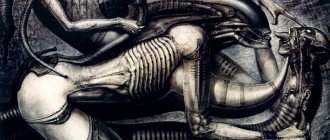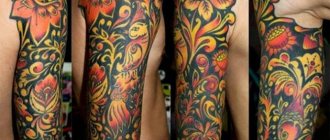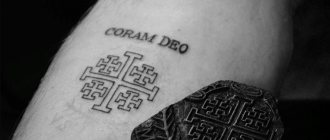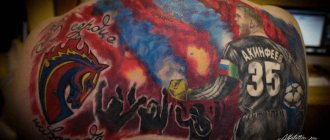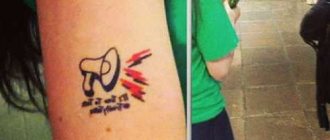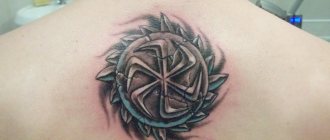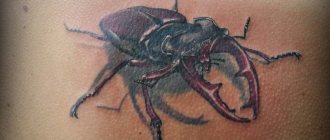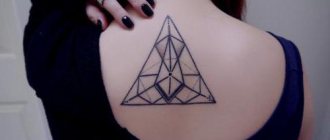A little about the Scythians.
The Scythians - a people who occupied the territory from the Danube to the Don. They differed by their belonging to Iranian-speaking tribes and preferred to inhabit the steppes. Large tribes were divided into ploughmen, kings and Scythian farmers. Scholars believe that the Scythians ceased to exist after the invasion of the Goths, being lost to the other ethnic groups. Today, the language closest to the ancient Scythian dialect is Ossetian.
Mention of the Scythians, in particular their traditions, can be found in the works of the famous philosopher Herodotus. One of them is the fact that after the first murder committed by a young Scythian, he had to drink the blood of the victim. According to another custom, members of one tribe would give their friends from another tribe drops of blood, which they would drink after adding to their own drinks. They also accepted blood from those to whom they addressed their own. Such actions were aimed at bringing people closer together. Scythian tattoos are not as bloodthirsty as the rituals of this people.
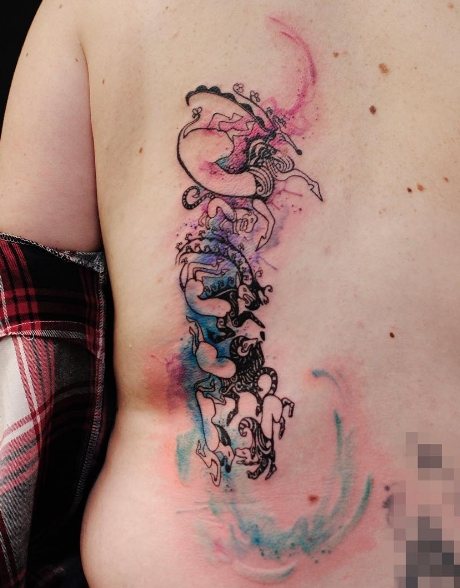
The Art of the Ancient Scythians
According to scientists, the Scythians devoted their time to a wide variety of arts. This is evidenced by excavations. These include tattoos, which in those days signified protection from evil spirits. Special attention was paid to animal images. Animals were drawn sideways, but their head was always directed at the person who was looking at them. This direction is called the "Scythian-Siberian style".


Interesting fact. Sensational were the excavations of scientists in the Altai. Thanks to them, it became known for sure that the Scythians inhabited this area as well. Special equipment made it possible to find tattoos on mummies that were members of the Scythian tribes during their lifetime. The body art was on various places. They were applied with soot. It is believed that material was used that was taken from the outside of cauldrons in which the tribes cooked food. The images would be impressed into the human skin and become darker.


Variety of style
In fact, Scythian motifs cannot be called a pure style like the Japanese style, for example. This is more a kind of conglomerate that combines the patterns of different nationalities. The point is that historians do not have a large number of accurate information on the Scythian people and their culture, and so results in a certain assortment made up of the known, and supplemented by what is more or less assimilated to the already known.
Hence the existing richness of the proposed forms, possible motifs, as well as the techniques associated with the decoration. The peculiarities of each image are usually emphasized, attention is paid to additional details and not only to the main ones. Very often, one picture blends in with another. In general, it is not surprising that the Scythian motifs are becoming more and more popular.
What do Scythian tattoos mean?
There have been many meanings of such tattoos. Some of them are still in place to this day:
- A demonstration of the wearer's status. By the tattoo, members of other tribes judged what status its bearer had; - belonging to a tribe. A tattoo depicting a symbol of the people could only be in specific places; - highlighting character traits. The tattoo says a lot about its owner; - protection. Scythian tattoos kept people away from evil spirits. Today, they give protection from evil spirits and the evil eye. In ancient times, it was believed that body art made the Scythians much stronger, which was so important in confronting the enemy.
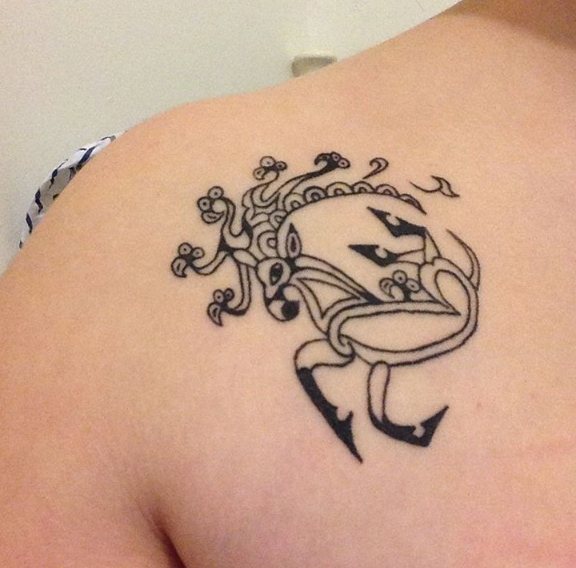

In ancient times, tattoos were simpler
About what kind of drawings were applied to the skin of the Scythians, archaeologists can judge by their mummies, found in ancient tombs.
The Scythians include Caucasoid mummies found in the territory of modern China: in the Takla-Makan desert, in the Tarim valley and the burial grounds in Xinjiang. Archaeologists believe that these may have been members of the Athanasian nomadic South Siberian culture, who lived about 3,800 to 2,000 years ago. These mummies are decorated with simple tattoos in the form of geometric figures and plant ornaments. Surprisingly, the drawings are red in color, which is consistent with the notes of Herodotus, who said that the Scythians painted their bodies with murica.
The faces of the mummies from the Subashi cemetery (Xinjiang) bear lines and spirals on the cheeks and forehead. One woman, for example, has yellow spirals descending from the upper eyelids of her eyes through the bridge of her nose to the wings of her nose, and her cheeks show red triangles with yellow spirals inside.
Where Scythian tattoos are applied
To prick such tattoos can be applied to various places on the body. Their sketches are quite complicated. Scythians also adhered to certain rules when applying drawings. For example, a symbol of the tribe was placed on the shoulder. Such tattoos had almost no differences among a particular tribe. Such an image indicated what society the person belonged to. There were quite a few tattoos that were placed on the fingers of the hands. The Scythians were very fond of putting images on the thumb because this part of the body, as the legends said, contains the human soul. There were tattoos indicating a person's character as well as tattoos of a protective nature.
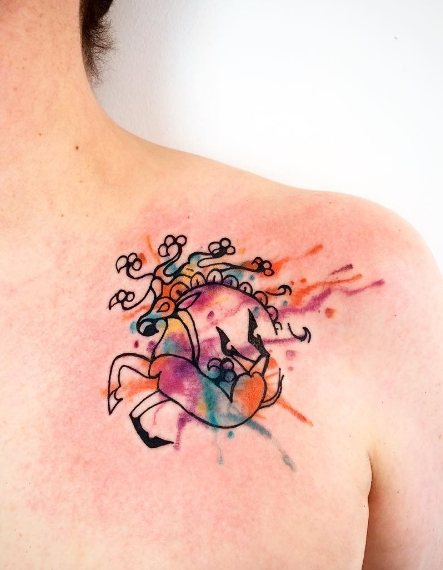



What distinguishes Scythian tattoos
These tattoos have their own characteristics:
- The presence of a large number of elements. Each image has many details; - the distribution of many elements within a certain space. Even a small tattoo can contain many details; - the image of large elements with small elements inside. For example, one animal can be in another.
An interesting fact. There were male and female Scythian tattoos. The female versions were very elegant. They were characterized by rounded elements, a variety of curls and smooth lines. Men's tattoos were distinguished by clear, straight lines.


Scythian tattoos were mostly represented by plant elements and geometric figures. Animals on tattoos are usually decorated with different ornaments. The image may contain numerous tridents, waves and even swastikas. Although there is a variety of tattoos, they can have a very concise appearance.
Scythian tattoos from the Great Pazyryk barrows
More than 60 years have passed since S.I. Rudenko's research of the Great Pazyryk barrows. As is known, in the Second and Fifth burial mounds were preserved mummified bodies of four buried: two of them, a man and a woman, in each mound. The body of the man from the Second barrow was covered with tattooed drawings [Rudenko, 1953, p. 136-140]. The next discoveries of tattoos on mummies of Pazyryk culture were made by Novosibirsk archaeologists on the Ukok plateau. In 1993 during excavations of Ak-Alakha-3 burial ground in kurg. 1, N.V. Polosmak discovered the mummified body of a woman with tattoos on her arms (Polosmak, 2000, fig. 3). In 1995 in the Verkh-Kaljin-2 burial ground V.I. Molodin investigated kurg. 3 with a mummy of a man whose shoulder was decorated with a tattoo of a figure of a hoofed animal [Molodin, 2000, fig. 143].
On these three mummies tattoos were discovered directly during excavations, as blue drawings stood out well on the light skin [Polomak, 2001, p. 228]. Soon after extraction from the burials the skin of the Ukok mummies darkened strongly and the drawings on it "disappeared". The color of the skin was restored only after special procedures [Kozeltsov and Romakov, 2000, p. 104].
The other three mummies from the Great Pazyryk barrows have dark brown skin, tattoos on it are not visible. Apparently, it was this skin not only when the materials were received by the State Hermitage but also during the excavations as changes in its color were not noted either by Rudenko or by other specialists. Perhaps they occurred during the opening of the mounds by ancient looters.
The mummies stored in the Hermitage were photographed, x-rayed and examined twice a year by the Biological Control Service, but no signs of tattoos were found. The discovery of drawings turned out to be a matter of chance.
Methodology for detecting tattoos.
The precursor of the discovery of images on three mummies from the Great Pazyryk barrows was the discovery of a tattoo on a mummy from the Tashtyk burial ground Oglakhty VI. The restorers, having removed the clothes from the mummy, noticed pale blue figures of vague outlines on it. The forensic experts, invited to examine the mummy, advised to photograph the drawings in infrared rays in order to "manifest" the barely visible images. Thanks to the photographic work of the Department of Scientific and Technical Expertise of the State Hermitage, it was possible not only to clarify the already noticed drawings, but also to detect other, invisible to the eye tattoos [Kyzlasov and Pankova, 2004]. Soon an idea arose to carry out the same procedure with the Pazyryk mummies, the presence of tattoos on which was highly probable.
In October 2004, three mummies from the Second and Fifth Pazyryk barrows were photographed in reflected infrared rays. It turned out that each of them had tattoos.
each of them had tattoos. The method of infrared photography "works" because of the soot in the dye used for the tattoo. The areas of skin covered with the tattoo absorb the infrared rays, while the clear skin reflects them intensely. As a result, the mummies' dark skin looks very light in the pictures, and the tattoos stand out contrastingly and clearly.
It is possible to draw the images only from photographs, which should reflect the tattooed figures as fully as possible. The drawings are located on the convex surface of the body, including on the limbs, so a whole series of consecutive pictures is needed to make the images unfold. However, the fixation possibilities are limited. First, the camera mounted on a fixed tripod can only move vertically and horizontally. To cover the entire surface, we have to move under the lens, repeatedly rotate and fix in a variety of positions the mummies themselves, which is not always safe for their safety and sometimes makes us limit ourselves to a minimum number of images. Secondly, the mummies are in a stiffened state, their limbs restrained. The images located on the inner surface of arms and legs can be fixed only at an angle, and sometimes even that is impossible. The small number of images, as well as the fact that some of them were taken at an angle, affect the drawing of images: the details of the figures do not fit together or are simply absent. In such cases you have to resort to reconstruction. Reconstruction from fragments is difficult creative work, as the "mechanical" joining of fragments does not ensure the authenticity of the images. In addition, the artist's work is complicated by the numerous folds and stitches in the skin, which distort the figures and do not allow the image to be completely recreated. Although the drawings are as close to the originals as possible, as evidenced by the photographs provided, it is desirable that they be refined when new methods of fixation or more advanced techniques appear*. [Footnote:
* Photographs were made by A.B. Sizov, senior researcher of the Department of Scientific and Technical Expertise. Sizov with the participation of S.B. Khavrin and K.V. Chugunov. The drawings were made by E.V. Stepanova, A.B. Silnov, D.A. Kirillova. To all participants of these works the authors bring their deep gratitude].
Description and characteristics of the tattoos.
The tattoos were found on the mummified body of a woman from the Second barrow, mummies of a man and a woman from the Fifth barrow. The image supplementing the known drawings on the mummy of the man from the Second barrow was also revealed. His body began to decompose and was dissected in the process of excavation, but the skin with the tattoos was preserved. In addition, the head and hand of the right arm of the buried man, cut off by robbers, were preserved. It was on the hand that the image was found
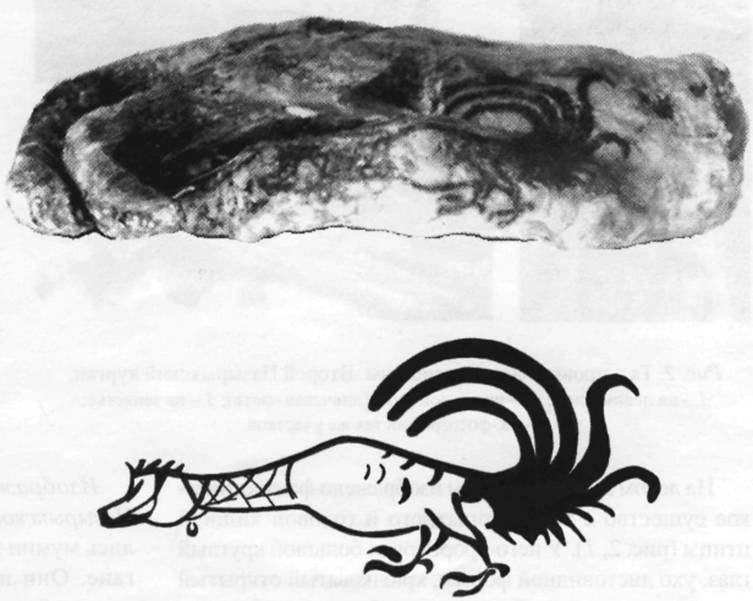

Fig.1 The image of a bird on the right hand of a man. Second Pazyryk barrow.
Image on the hand of a man from the Second Pazyryk barrow.
The thumb depicts a bird, with its head facing the nail, with a lush tail extending to the metacarpal (Fig. 1). The bird has a small head with a scallop and a beard; its elongated neck is covered with plumage decorated in the form of an oblique net. There are spurs on the legs, further indicating that the bird is depicted as a rooster.
Images on the body of a woman from the Second Pazyryk barrow.
A woman of just over 40 years of age was buried in the same deck as the man; her body was better preserved than that of the man. She too had been decapitated by robbers, who also cut off her right hand, feet and shins. The skin of the mummy has been badly damaged and the drawings have been partially lost, but the figures are still recognizable due to their resemblance to other known tattoos.
A fantastic creature with the body of a ungulate and the head of a bird of prey is depicted on the left shoulder of a woman (Fig. 2, 1
). It has a large round eye, a leaf-shaped ear, a hooked open beak with a wax head. The creature is depicted with large blackened horns; one of the horns has bird-head-like outgrowths. On the main trunk the horns are forward-facing, and on the two anterior ramifications they are backward-facing. The hind half of the animal's body is turned out, and its whole figure forms a circular composition. The body is shown with an outline, and the legs are blacked out. On the chest of the fantastic creature can be seen blackened curvilinear figures, similar to the decor of similar tattoos on other Pazyryk mummies. However, it is no longer possible to restore their outlines.
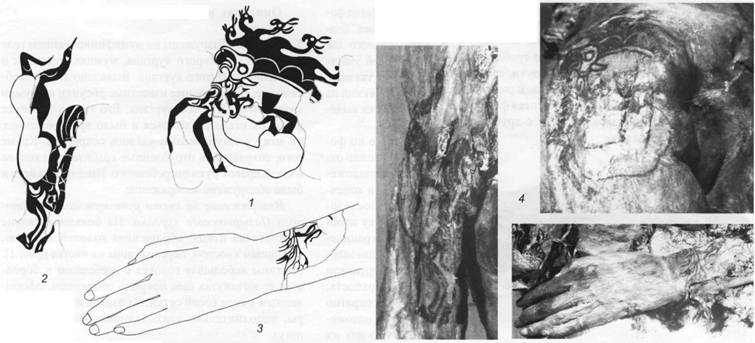

Fig. 2. Tattoos on the body of a woman. Second Pazyryk barrow. 1 - on the left shoulder; 2 - on the right arm (shoulder part); 3 - on the wrist; 4 - IR-photographs of the same areas.
The shoulder part of the right arm of the woman depicts a figure of a argali with an everted croup (Fig. 2, 2
). The animal has a steeply curved horn with annual rings and thick wool on its chest. The body and front legs are shown in outline, the hind legs are blackened and covered in a curvilinear pattern.
Just above the wrist on the outer side of the left hand is a realistic drawing of a deer antler with a number of ramifications (Fig. 2, 3
). With the hand lowered, the horn appears inverted. It is difficult to say whether it was an independent image or only a part of the deer figure. Apparently, the tattoos were also located above, on the forearm, but the skin is destroyed here.
In terms of the manner of execution, the images on the female mummy from the Second Pazyryk barrow are similar to the tattoo on the body of the man from the same complex. On both mummies the figures of the fantastic creature and the argali are located identically. The figures of the female tattoo differ somewhat in their smaller size and single placement. The inverted horn shown on the left wrist is similar to the horn depicted together with a deer head on the body of a woman from Ak-Alakha-3. Thus, the tattoo on the body of a woman from the Second Pazyryk barrow is represented by drawings very close to the previously known images on the mummies from the same complex and the Ukok barrows.
Images on the mummy of a man from the Fifth Pazyryk barrow.
Mummies of the buried in the Fifth Pazyryk barrow are much better preserved. They are dry light bodies with dark wrinkled skin (Fig. 3). A man 55 and a woman 50 years old were buried in the same well [Barkova, Gokhman, 2001].


Fig. 3. Mummy of a man. The fifth Pazyryk barrow


Fig. 4. Tattoo on the left shoulder of the man. Fifth Pazyryk barrow.
The images on the man's body are located on the shoulders, back, arms and legs below the knees. Especially impressive is the tattoo in the form of a predator of the feline family covering the left shoulder: the large head, turned in profile, occupies the entire shoulder in front, the front paws descend on the arm, the rear part of the body, the paws and tail are thrown over the back, up to the spine (Fig. 4).
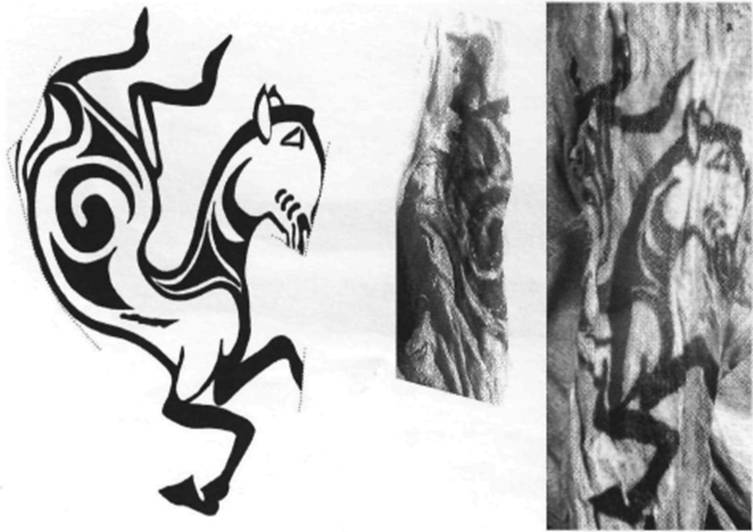

Figure 5. Tattoo on the right arm of a male (shoulder part). The fifth Pazyryk barrow.
The front part of the figure is covered with blacked-out patterns forming spirals and curved triangles,
and the back is left "clean", contoured. Hind paws of the tiger are shown as if in perspective; the ratio of forelegs is not clear because of the skin fold between them. A peculiarity of the drawing is a profile depiction of the predator's eye, rarely seen in Pazyryk art. The closest analog of the image of tiger are carved figures of predators on the deck from the Second Bashadar barrow [Rudenko, 1960, fig. 21].
On the shoulder part of the right arm, a horse is depicted with its croup turned upward and its hind legs thrown upward (Fig. 5). Its thigh and neck are filled with blackened curvilinear figures. The legs and mane are also blackened. The horse is shown with large, protruding ears, leaf-shaped, large eyes, depicted in profile with a high upper eyelid. His mouth is ajar, with crescent-shaped folds conveying a grin. The latter detail, together with a dynamic pose gives the animal a somewhat aggressive look. Unfortunately, the image of the muzzle of the horse is blurred by deep folds of skin and is not visible. The animal's tail cannot be completely fixed either.
On the forearm of the same hand, two animals are depicted - a kulan or horse and a predator with a striped tail twisted into a ring (Fig. 6). The figures are oriented with their heads downward (toward the hand). The horse's croup is inverted. Its tail is pulled down at the base and is divided in two at the end. This detail, in the opinion of M.A. and E.G. Devlet, typical of the images of sacrificial animals [2004]. The outline drawing of the horse's head is very expressive: a large almond-shaped eye and a slightly open mouth with thick blackened lips are shown. The curl on the neck of the animal is not quite clear. The artist's interpretation of it as a strand of mane raises some doubts.
It is not possible to fully restore the composition, as the image of the predator is broken with stitching and represented fragmentarily in the photographs. Reading the scene is facilitated by the existing similarity with the image of a kulan with an everted croup and a predator with a striped tail on the right forearm of a man from the Second Pazyryk barrow [Rudenko, 1953, fig. 82].
Two figures are tattooed on the back and buttock of the mummy (Fig. 7). One of them, to the right above the waist, is visible in fragments because of the deep crease that hides the upper half of the image. From the remaining fragment, we can imagine that an animal with four legs and a tail is depicted. The other image, on the left buttock, is probably broken by a stitch and in this form represents some kind of swastika-like figure, in which we can see either the legs and head of the animal, or a composition with a griffin head. It may be noted that in the pictures it looks more faded than the other figures of the tattoo.
There are also tattoos on the hands of both hands of the man. The bases of the thumbs symmetrically show figures of "walking" birds, with their heads facing toward the nail.
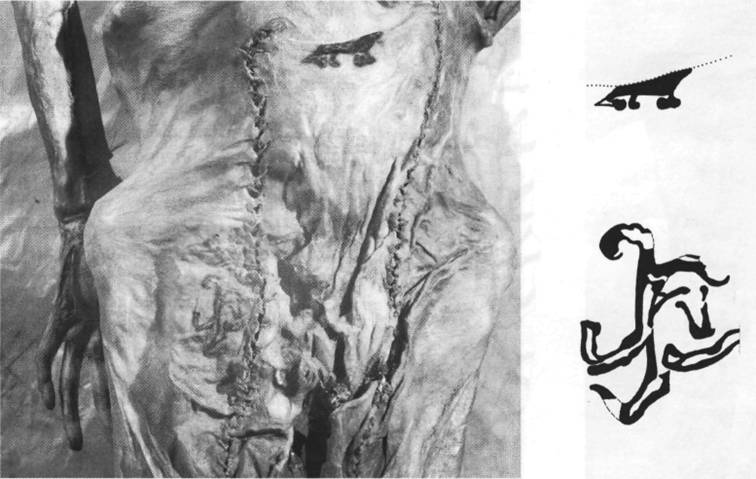

Fig. 7. Tattoos on the back of the man. Fifth Pazyryk barrow.
On the hand of the right hand (Fig. 8, 2
There is a bird with an elongated long neck, a small head, and a curved thick beak. The drawing is executed with contour line. In the outline of the head a scallop and a beard can be guessed. The bird has a streamlined body, legs in "pants", as well as a large lush tail, the rudder feathers of which curve in the form of horns. This is probably a depiction of the black grouse or wood grouse [According to Bram A.E. ..., 1937, pp. 267-268].
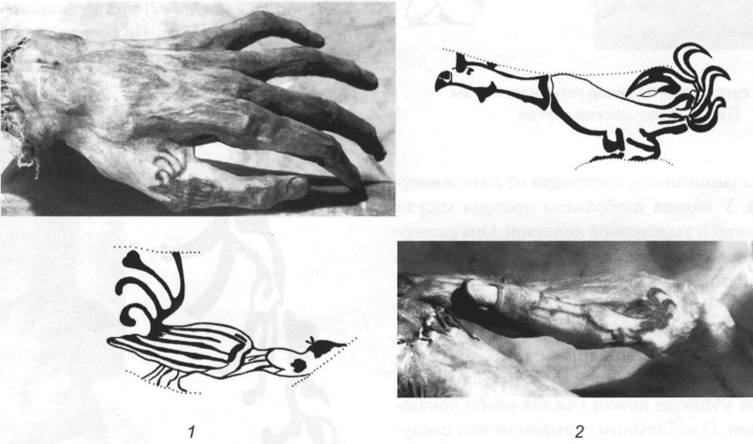

Fig. 8. Tattoos on the hands of the left (1) and right (2) hands of a man. The fifth Pazyryk barrow
The left hand depicts another bird (Fig. 8, 1
). The outlines of its head and neck are poorly preserved. The folded wings are accentuated with blacked-out stripes, the large flared tail is raised high. Treatment of wings in the form of longitudinal strips corresponds to the manner of depiction in Pazyryk art of waterfowl, which, however, is not characterized by luxuriant tails.
The tattoo covers both legs of the man below the knees. On the left leg, on the inner surface of the shin, a composition is represented,
Fig. 9. Tattoos on the man's left shin. Fifth Pazyryk barrow
consisting of five animals (Fig. 9). At the knee, the protoma of roe deer with a front leg and a distinguished scapula is depicted. It is unfolded horizontally, in contrast to the ungulate line below, the movement of which is directed from the foot to the knee. The three figures represent female roe deer or argali. They have similarly proportioned and sized bodies, their heads are raised, muzzles are outlined with a clear contour line, lips and horns are blackened. Four graceful legs of each individual are shown in motion. With a slight break from them follows the argali.
On the right leg of the man in front, at the transition point between the foot and the shin, two ungulates are shown walking upwards (Fig. 10). It is likely that the master depicted goats. Their heads, horns and necks are blacked out, their legs are slightly bent, the shoulder blade and thigh are shaped with scrolls. The movement of the animals is conveyed by the four legs spread in stride with carefully marked hooves.
In general, the animal figures on the male mummy from the Fifth Pazyryk barrow in the manner of depiction are similar to the tattoos on the mummies from the Ukok and Second Pazyryk burials. Their peculiarities are the filling of the front part of the figures with curvilinear patterns (tiger), decorative design of images with spirals and triangles. Similarities can also be seen in the subjects themselves. The tattoo examined is most similar to the drawings on the body of the man from the Second Pazyryk barrow: the images of birds on the thumbs, the figures of kulan (?) and predator on the right forearm, the line of ungulates on the shin are the same. The tattoos are also similar in the system of images, although the figures are placed less densely and do not form a "carpet" ornament.
At the same time on the drawings on the body of the man from the Fifth Pazyryk barrow there are no specific fantastic characters characteristic for the tattoos on the buried in the Second Pazyryk, Ak-Alakha and Verkh-Kalji barrows, their place is taken by the figure of a tiger.
The tattoos on the body of a man from the Fifth Pazyryk barrow vary in style. For example, the figures of a tiger and a horse on his shoulders are executed with characteristic stylization, while the figures of ungulates on his left shin are transferred schematically. It is quite possible that the individual tattooed drawings were made by different masters and probably at different periods of the buried person's life.


Fig. 10: Tattoos on the right leg of a man. Fifth Pazyryk barrow
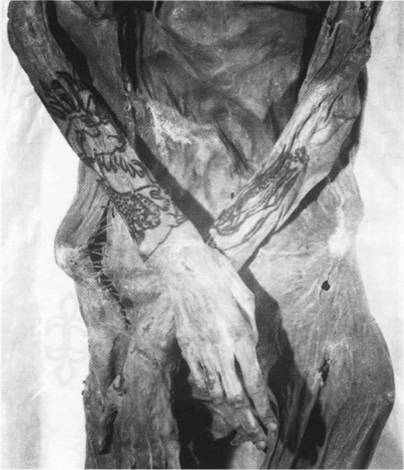

Fig. 11. tattoos on the hands of a woman. Fifth Pazyryk barrow
Images on the mummy of a woman from the Fifth Pazyryk barrow.
They differ in location from other known Pazyryk tattoos
On this mummy there are no drawings on the shoulders, "the most visible and convenient surfaces for tattooing" [Polosmak, 2001, p. 235], but the forearms are covered with whole compositions (Fig. 11).
On the left arm there is a scene of torment: a large bird of prey clutching at the collar of a deer (elk?) (Fig. 12). The deer is depicted falling down, its front legs bent, hind legs stretched out helplessly, the back part of the body twisted. The head, depicted on the inner surface of the arm, could not be fixed, only the ear and the shovel-like horns can be seen. On one of the horns we can see the offshoots, but, unfortunately, it is unclear whether they have the usual outlines or are represented by bird's heads.
The image of the bird is disturbed by stitching and distorted by skin folds. The bird's head shows large protruding ears and a predatory curved beak; the plumage on the neck is obliquely netted. A clawed paw is clearly visible. The bird's tail or wing ends in a bird's head.
Separate tattooed figures are represented on the hands of a woman (Fig. 13). On the thumb of the left hand, a bird with a puffy tail, moving to the wrist, is depicted with its head toward the nail (see Figs. 12; 13, 2
).
Fig. 12. Tattoos on the left hand of a woman. Fifth Pazyryk barrow.
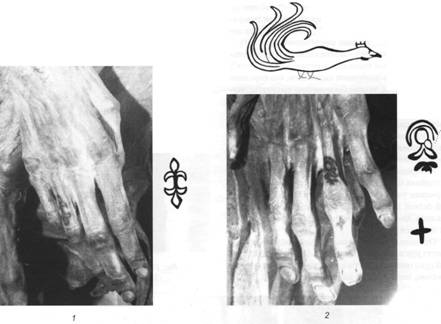

Fig. 13. Tattoos on the hands of the right (1) and left (2) hands of a woman. Fifth Pazyryk barrow.
The bird has a scallop on its head and a small blackened beard - probably depicting a rooster. On the ring finger of the same hand is a tattoo of a figure based on a circle with an adjoining plant composition - a lotus bud with two sepals. On the neighboring phalanx of the same finger we can see a cross, although it is paler in tone than the other tattoos (see Fig. 13, 2
).
On the ring finger of the right hand a figure in the form of opposing three-petaled palmettes is shown (Fig. 13, 1
). Similar palmettes are common in the decoration on Pazyryk felts, wooden and leather objects, but in tattoos the plant motifs are found for the first time.
On the right arm of a woman from the elbow to the wrist there is a complex multifigure composition. Two tigers and a leopard attacking a deer and a moose are depicted (Fig. 14).
A stag with enormous antlers is depicted at the top, with a tiger ready to catch it by the horns and its front leg. The deer is shown in profile so that one can clearly see its two forelegs and two hind legs with clearly visible hooves. The head of the animal is crowned by a huge arched curved horn with several branches. The stag has a pair of protruding leaf-shaped ears, an almond-shaped eye and an open mouth. The figure of the tiger attacking from the front is depicted from a complex perspective: the rear part is represented in profile, the front part in facial view, and the head as if seen from above. The body is entirely covered with S-shaped lines emphasizing the texture of the tiger's fur.
In the lower part of the composition a moose (or a spotted doe?) is represented; a leopard has clung to its body and a tiger has grabbed it by its front legs. An elk with a "twisted" croup is trying to fight off an attacking predator. The elk has a broad-bladed horn with two foreparts, a large almond-shaped eye and a pair of ears placed one under the other.
The figure of the leopard (ounce) is depicted using a familiar method: the hind part of the body is turned almost in profile, the front part is shown in full-face, and the head is depicted as seen from above. The body of the predator is covered in dark spots, with a special emphasis on the spine, marked by double spots from the head to the shoulder blades. The curve of the leopard's back and the contour of the elk's horn are depicted in one line. It is not quite clear how the left paw of the predator is depicted - its outlines correspond to the outline of the neck
Moose's neck, but it is not shown completely. In general, the drawing around the moose neck is not very clear. Between the head and forelegs of the ungulate, the photograph reads a paw-shaped figure, and above it, a spot-filled area.
To the right of the moose is a figure of a tiger. His flexible body is strongly elongated and outlined with smooth lines, his hind legs widely spaced. The position of the tiger's right paw remains unclear. The animal's pelt is elaborated with S-shaped stripes.
In general this complex multi-figured composition is closed. It is bounded on the top by deer antlers, on the left by the legs of ungulates and the body of the leopard, on the bottom by the lying body of the elk, and on the right by the figures of two tigers. All the elements of the composition are balanced and subordinated to the author's intention, which may indicate the existence of a sketch or marking that preceded the tattoo.
The images on the body of the woman from the Fifth Pazyryk barrow differ markedly from other known tattoos. They are stylized differently and do not include distinctive fantastical figures. The tattoo on the right arm of the woman is particularly notable: such complex compositions are not known in Pazyryk art, and probably not among the works of the Scythian animal style in general.


Fig. 14. Tattoo on the right arm of a woman. Fifth Pazyryk barrow.
However, in terms of subject matter, predator postures and individual depiction techniques, these drawings certainly find analogies in works of Scythian art. Figures of predators, with the front part of the body in frontal perspective and the rear part in profile, are known on the images from the Seven Brothers barrows [Artamonov, 1966, p. 120, 122]. Predators of the cat family, depicted in the same poses as on the tattoo, are among the zoomorphic images on saddle covers from the First and Second Pazyryk barrows [Rudenko, 1948, table V; Gryaznov, 1950, fig. 35, 37]. Drawing of tigers' fur in the form of separate S-shaped strips is shown on a number of objects found in the First and Second Pazyryk barrows and kurg. 1 Ak-Alakhi-3 [Gryaznov, 1950, fig. 35, 36; Table XIII; Rudenko, 1948, Table VI; Polomak, 2001, fig. 141]. The master was,
The master was undoubtedly familiar with the Pazyryk image tradition. And yet it is difficult to get rid of the feeling that this tattoo is performed in some other artistic tradition.
This may be evidenced by other available parallels. The closest analogies to the drawing of tigers' fur are presented on the paired gold plaques with the image of animal fighting from Ordos burial ground Sihoupan, could. 2 . This is also the origin of gold plaques in the form of
Fantastic characters, similar to the famous "horse-griffins" of Pazyryk tattoos, and on the bodies of these Ordos creatures the same S-shaped stripes are shown [Kovalev, 1999, fig. 2, 3
]. The fur on the bronze figure of a tiger with hieroglyphs inlaid with gold S-shaped strips is marked in a similar way [Scarpari, 2003, p. 2-3]. The named objects come from the territory of China and are dated accordingly to the end of the IV-III century BC and the Western Han era. The lower tiger on the tattooed composition by its pose reminds the figure of predator on the mirror from Ilmovaya Padi [Rudenko, 1962, fig. 65,
б
], reflecting the iconography of Han time [Scarpari, 2003, fig. 54-55; James, 1979, fig. 6; Hartman-Goldsmith, 1979, fig. 4]. The image of the leopard is characterized by the combination of two features: the front part of the body is shown in full-face, and the ridge is emphasized. Other images executed in such a manner are unknown in Pazyryk art. The marked combination is presented on a ceramic plaque - a fragment of a 3rd century BC relief composition from the territory of Northern China (Guimet Museum, an accidental find) [Mongolie, 2003, p. 207].
In general the tattooed composition resembles the images on the bronze plaques of the "horsemen's group" of Dien (Dian) culture in the upper Yangtze River (Deopik, 1979). These objects, representing one of the varieties of the animal style, are characterized by multi-figured scenes of torture, realistic manner of performance and the presence of cartouches closing the compositions, i.e. the same features that distinguish the scene on the skin of the buried woman in the Fifth Pazyryk barrow
Thus, the images of this tattooed composition are different from the "classical" Pazyryk ones and probably have something to do with the territory of China. Their analogues found in this region belong to a later time than the traditional date for the Great Pazyryk barrows, but by chronological definitions they correspond to the Chinese items from the Third, Fifth and Sixth Pazyryk barrows (3rd c. BC) [Bunker, 1991; Chugunov, 1993].
Conclusion.
With the identification of "new" images the number of known tattooed mummies - representatives of the Pazyryk culture - doubled. It is important that tattoos are represented on all preserved mummies from the Great Pazyryk barrows. Unfortunately, there are no drawings on the faces of these mummies.
The discovered images show that Pazyryk tattoos were more diverse than previously imagined. In particular, fantastic creatures, considered one of the main characters of Pazyryk mythology, are not an attribute of all tattoos. The images on the skin of the buried in the Second Pazyryk barrow, Ak-Alakh and Verkh-Kaljin are united by common stylistic techniques and characters and constitute a compact series. It is this group that is characterized by figures of fantastic "horse-griffins".
The tattoos found on the mummies from the Fifth Pazyryk barrow differ markedly from the drawings on the skin of other buried people. The images on the man's body still retain continuity with the tattoos from the Second Pazyryk barrow. The tattoo on the woman falls out of the traditional circle of Pazyryk images. The analogues given for her belonging to different areas of China once again focus attention on the problem of chronology of the mounds of the Great Pazyryk chain.
According to the data of dendrochronology, of the four complexes in which mummies with tattoos were found, the first was the Second Pazyryk barrow, about 20 years later came the Ukok barrows, after another 26-28 years the Fifth Pazyryk barrow [Slusarenko, 2000, p. 128; Vasiliev, Slusarenko, Chugunov, 2003, p. 25; Marsadolov, 2003, p. 94]. Consequently, four tattoos of "fantastic" series are connected with relatively early monuments.
The specificity of the tattoos on the mummies from the Fifth Pazyryk barrow may be explained by the later time of its construction. However, more significant may be the presence of items of Chinese origin in the materials of the monument, indicating the relevant contacts.
The presented materials are a rich source, the comprehension of which has only just begun. The authors have mainly focused on the description, although they have allowed themselves to express some judgments. More substantial conclusions require, above all, time and in-depth study of the material.
List of references.
